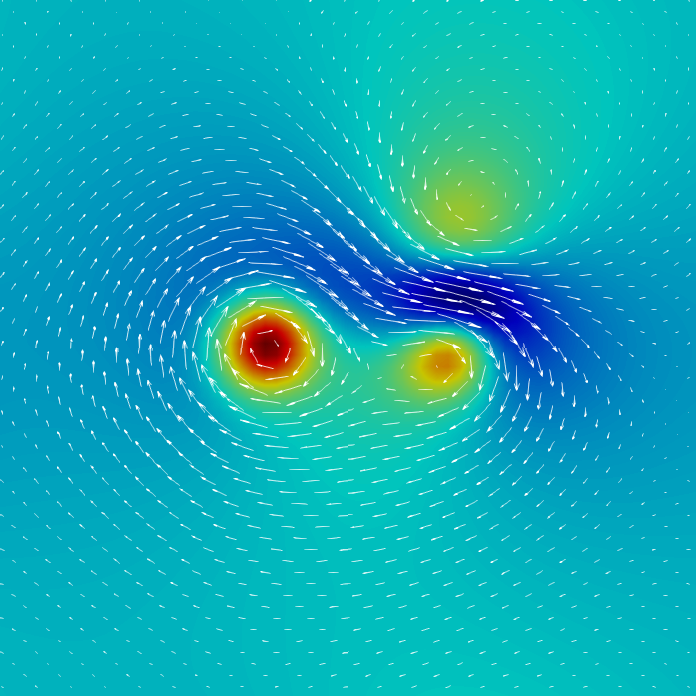Felt i naturen, skalar- og vektorfelt, skalering
- Pensum
- Kapittel 1 i Matthews
- Kapittel 1 i Gjevik og Fagerland
- Mål
- Lære å regne med vektorer
- Utforske bruk av vektorer i Geogebra
- Skalering av likninger
Vektorer og punkter - 2D
Et punkt har to koordinater i $\mathbb{R}^2$
P: $(x, y)$
En vektor har to komponenter som skalerer to enhetsvektorer: $\vec{r} = x \color{red}{\mathbf{i}} + y \color{green}{\mathbf{j}}$
Vektorer og punkter - 3D
Et punkt har tre koordinater i $\mathbb{R}^3$
P: $(x, y, z)$
En vektor har tre komponenter som skalerer tre enhetsvektorer $\vec{r} = x \color{red}{\mathbf{i}} + y \color{green}{\mathbf{j}} + z \color{blue}{\mathbf{k}}$
Posisjonsvektor vs vanlig
En posisjonsvektor starter
alltid i origo
En vanlig vektor er en
funksjon av posisjon
Vektor addisjon
2 dimensjoner
| $\vec{u}=$ | $u_x\mathbf{i}$ | $+ u_y \mathbf{j}$ |
| $\vec{v}=$ | $v_x\mathbf{i}$ | $+ v_y \mathbf{j}$ |
| $\vec{u} + \vec{v}=$ | $(u_x+v_x)\mathbf{i}$ | $+ (u_y+v_y)\mathbf{j}$ |
3 dimensjoner
| $\vec{u}=$ | $u_x\mathbf{i}$ | $+ u_y \mathbf{j}$ | $+ u_z \mathbf{k}$ |
| $\vec{v}=$ | $v_x\mathbf{i}$ | $+ v_y \mathbf{j}$ | $+ v_z \mathbf{k}$ |
| $\vec{u} + \vec{v}=$ | $(u_x+v_x)\mathbf{i}$ | $+ (u_y+v_y)\mathbf{j}$ | $+ (u_z+v_z)\mathbf{k}$ |
Vektor subtraksjon
2 dimensjoner
| $\vec{u}=$ | $u_x\mathbf{i}$ | $+ u_y \mathbf{j}$ |
| $\vec{v}=$ | $v_x\mathbf{i}$ | $+ v_y \mathbf{j}$ |
| $\vec{u} - \vec{v}=$ | $(u_x-v_x)\mathbf{i}$ | $+ (u_y-v_y)\mathbf{j}$ |
3 dimensjoner
| $\vec{u}=$ | $u_x\mathbf{i}$ | $+ u_y \mathbf{j}$ | $+ u_z \mathbf{k}$ |
| $\vec{v}=$ | $v_x\mathbf{i}$ | $+ v_y \mathbf{j}$ | $+ v_z \mathbf{k}$ |
| $\vec{u} - \vec{v}=$ | $(u_x-v_x)\mathbf{i}$ | $+ (u_y-v_y)\mathbf{j}$ | $+ (u_z-v_z)\mathbf{k}$ |
Vektor algebra er komponentvis
$ \begin{align*} \begin{pmatrix}{\red{u_x} \\ \green{u_y} \\ \blue{u_z}}\end{pmatrix} + \begin{pmatrix}{\red{v_x} \\ \green{v_y} \\ \blue{v_z}}\end{pmatrix} &= \begin{pmatrix}\red{u_x + v_x} \\ \green{u_y + v_y} \\ \blue{u_z + v_z} \end{pmatrix} \\ \end{align*} $ $ \begin{align*} \begin{pmatrix}{\red{u_x} \\ \green{u_y} \\ \blue{u_z}}\end{pmatrix} - \begin{pmatrix}{\red{v_x} \\ \green{v_y} \\ \blue{v_z}}\end{pmatrix} &= \begin{pmatrix}\red{u_x - v_x} \\ \green{u_y - v_y} \\ \blue{u_z - v_z} \end{pmatrix} \\ \end{align*} $Vektor skalering
En vektor skaleres komponentvis
$ \begin{align*} \alpha \vec{u} &= \alpha(u_x \red{\mathbf{i}} + u_y \green{\mathbf{j}} +u_z \blue{\mathbf{k}}) \\ &= (\alpha u_x \red{\mathbf{i}} + \alpha u_y \green{\mathbf{j}} + \alpha u_z \blue{\mathbf{k}}) \end{align*} $På matriseform
$\alpha \begin{pmatrix}{u_x \\ u_y \\ u_z}\end{pmatrix} = \begin{pmatrix}{\alpha u_x \\ \alpha u_y \\ \alpha u_z}\end{pmatrix}$Vektor skalering endrer størrelsen, ikke retningen
Fart og hastighet
Fart er en skalar lik lengden av hastighetsvektoren
Fart = $|\vec{u}|$
